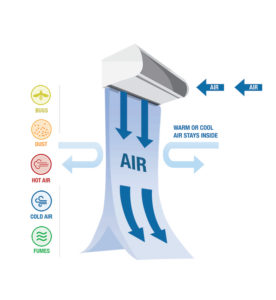There are many components in industrial ventilation systems to help keep the air in your facility clean and comfortable. Ventilation systems aim to improve comfort through cooling or heating as well as reducing contaminants in the indoor environment for proper indoor air quality. Air curtains are one piece that may help with both of these aims for your ventilation systems. Read on to learn more about air curtains and why you might need them in your building.
Why Use Air Curtains in Industrial Ventilation Systems?
Air curtains are a useful tool in many industrial ventilation systems. There are several reasons why our specialists may recommend air curtains for your building.
What are Air Curtains?
Air curtains are a type of ventilation equipment that create an invisible curtain of air at doorways and other openings in a building. Using a stream of air, they effectively seal the interior of the building from the exterior without physical doors or other obstructions. They do this by using a high velocity air stream that extends from the top to the bottom of an opening. They achieve this by using a powerful fan that forces air through a nozzle that extends the width of the doorway or opening.

How Do Air Curtains Help with Industrial Ventilation Systems
There are many advantages of using air curtains as part of your industrial ventilation systems. The high velocity air discharged by an air curtain acts as a barrier between indoor and outdoor environments. Here are a few key ways air curtains can help keep your facility clean, safe, and comfortable:Air Curtains Help Keep Contaminants Out
Air curtains, also known as air doors, are a great way to keep contaminants from entering your building even when you have doorless entryways or frequently opened doorways. The wall of air allows people and equipment through the doorway but stops pollutants and contaminants in their tracks. For example, air curtains provide a barrier to stop things like:- Dust
- Dirt
- Fumes
- Small debris
Air Curtains Prevent Pests from Entering Your Building
In addition, air curtains can also help stop common pests from making it into your building. Some of the biggest concerns when it comes to pests are small insects like flies, mosquitos, and wasps. However, small flying insects are no match for air curtains in your industrial ventilation systems. They basically hit a wall of air that they can’t penetrate to enter your building. Therefore, installing air curtains can prevent pest intrusion for your facility, which is important not only for the comfort of your employees, but may also be necessary for keeping your products clean and sanitary.Air Curtains Help Keep Treated Air from Industrial Ventilation Systems Inside the Facility
Perhaps one of the most common reasons to use air curtains for industrial ventilation systems is to keep cooled or heated air inside the building for proper temperature control and worker comfort. If your facility uses equipment like evaporative coolers, heaters, and dehumidifiers, then it’s important to keep that treated air inside your facility to improve comfort and reduce energy. Every time you open a door, there’s the opportunity for treated air to escape and let in untreated air that brings with it heat, cold, or moisture. Air curtains basically insulate the doorway to prevent this to improve comfort and save on energy consumption for your facility.Applications for Air Curtains in Industrial Ventilation Systems
Many different types of facilities use air curtains as part of their industrial ventilation systems. It’s common to use air curtains in buildings like:- Warehouses
- Distribution centers
- Power plants
- Manufacturing facilities
- Food processing facilities
- Pharmaceutical plants
- Laboratories
- Data centers
- Electronics manufacturing
- Cold storage facilities
